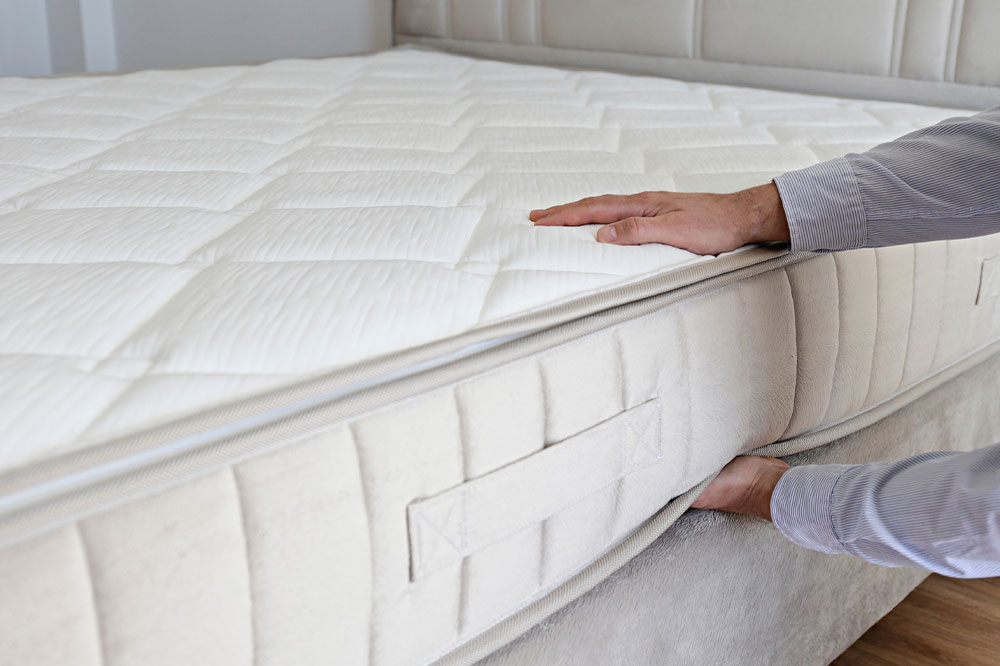Factors to consider before buying a new mattress

Picking out the perfect mattress is one of the most important home-makeover decisions you can make for a consistent good night’s sleep. With so many options available, from materials used and features offered to affordability and longevity, it may seem unnerving to navigate the market to find the right one for you. While buying a mattress is ultimately a matter of personal preference, here are some things to consider before choosing a new one:
Type of mattress
Memory foam and innerspring mattresses are the most popular choice among people. However, there are many other types of mattresses that you can opt for, depending on your requirements.
Memory foam
Memory foam mattresses offer the best pressure relief. They can conform to the body and take the weight off the pressure points for a comfortable night’s rest. These are ideal for side sleepers or those experiencing back pain because they promote proper spine alignment by reducing the pressure on the shoulders and hips. The only downside of conventional memory foam mattresses is that they can trap heat more easily and may be uncomfortable for hot sleepers.
Latex
Latex mattresses are more resilient than memory foam mattresses, which makes them firmer with less sinking in. Eco-conscious shoppers may opt for mattresses made with natural latex, but these can be more expensive than others.
Innerspring
These beds are made of steel coils, making them ideal for back and stomach sleepers. Innerspring mattresses are also popular as box mattresses and are quite popular across the country. When choosing an innerspring mattress, consider both coil gauge and coil count to find the perfect fit for your bed.
Hybrid
Hybrid mattresses use a combination of memory foam or latex and coils. They are a popular offering by many online mattress brands. Generally, the coil sits at the bottom for support, and the foam sits on top for pressure relief.
Adjustable
Although these mattresses are less common, they have air chambers that allow you to control firmness levels. These are especially useful for couples with different preferences when it comes to mattress firmness for quality sleep.
Mattress sizes
Check your room and your mattress dimensions to pick the correct size. The size range includes Twin (38” x 75”), Twin XL (38” x 80”), Full (54” x 75”), Queen (60” x 80”), King (76” x 80”), and California king (72” x 84”). Queen is the most popular size choice, but a King size mattress is ideal for two sleepers if you have enough space.
Firmness levels
Mattresses are commonly described as soft, medium, medium-firm, and hard. Brands often describe their mattress firmness levels on a scale of 1 to 10, with 1 being the softest and 10 being the firmest. Medium to medium-firm beds is generally the most popular choice, as they fit a wide variety of sleepers. Your sleeping position can also help you decide your ideal mattress firmness level.
Side-sleepers
This is the most common sleeping position and one that doctors recommend to avoid back pain. Soft-to-medium mattresses are best for side sleepers, as it helps keep the spine aligned. A firm mattress may end up putting too much pressure on the hips and shoulders.
Stomach sleepers
A firm mattress is more suitable for stomach sleepers, as it prevents their pressure points from sinking in too far.
Back sleepers
A medium-firm mattress is ideal because a mattress that is too soft or too firm increases the risk of improper back alignment.
Combination sleepers
A medium-firm mattress is best to support your various positions if you move around at night.
Sleep concerns
Apart from the right mattress type and firmness levels, it is important to consider personal sleeping concerns before purchasing a mattress.
Hot sleepers
For those who tend to overheat in their sleep, a cooling mattress can help maintain optimal temperature and help you sleep comfortably. Common cooling technologies to look for include:
Built-in cooling technology: Embedded metal particles and gel-cooling technology can be added to foam beds to draw heat away from the body prevent overheating, and promote temperature regulation.
Cool-to-the-touch materials: Some cooling mattress covers can have an instantly chilling effect to promote better sleep. However, they most likely will not remain cool overnight.
Breathable construction: Innersprings and some hybrid mattresses allow better air circulation in comparison to all-foam mattresses.
Electric cooling: Some plug-in options also use water or air to cool the bed. Although they are more high-maintenance, they are a great way of keeping the mattress continuously cool overnight.
Back pain
The best mattress for those with back pain offers some form of pressure relief with foam, along with medium firm support for spine alignment. The right mattress can help alleviate up to 50-60% of the pain and discomfort associated with the back.
Construction features
While some of these features may not be at the top of your priority list while shopping, they can make or break your mattress experience. Some key factors to keep in mind include the following:
Motion isolation: For those with partners who move around frequently in their sleep, it is ideal to get a mattress with motion isolation so that you can sleep soundly. Foam beds generally cancel motion better than innerspring beds.
Modular firmness: Sleeping partners with different mattress preferences should consider getting a split bed with interchangeable firmness levels.
Edge support: For those who prefer to sleep on the edge of the bed, mattresses that sink on the sides can cause discomfort. Generally, low-cost beds and foam mattresses that are shipped in a box tend to offer less edge support.
Mattress height: Taller mattresses (14 inches or higher) feel more luxurious to sleep on due to the many layers it contains. However, shorter mattresses cost less and are easier to set up.
Although there is no expiration date on mattresses, a good one lasts anywhere between 8 to 10 years. However, instead of time, consider checking for mattress health, like lumps or indents, and whether it is causing you any trouble before deciding to get a new one.


